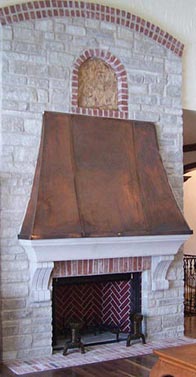Copper: An Element of Good Design
Copper and its many alloys have long played an important role in the design and architecture of residential and commercial buildings. Today, more than 10,000 years after the discovery of the "red metal," new and innovative ways to utilize copper, brass and bronze are being employed, especially in interiors.
A key aspect of interior design is that it can evoke certain emotions in occupants. Copper's warm, organic, natural appearance is said to promote an atmosphere of tranquility, peace and calm. Leatrice Eiseman, executive director of the Pantone Color Institute, recently stated, "Copper and the varicolored copper alloys invite a nurturing feeling, and in the stressful times we are living in, the need to embody warmth resonates with a lot of people."
 Accessories like this copper fireplace hood enhance many of today's homes.
Accessories like this copper fireplace hood enhance many of today's homes.High-resolution version of this photo.
Building occupants, particularly those with computer networks and high-end audio or home-theater setups, use copper-shielded cabling to take advantage of the metal's radio frequency (RF) shielding properties. Properly designed and constructed copper enclosures can effectively protect against RF interference, as well as from unauthorized surveillance. This type of shielding is routine for business computer users and electrical switching operations, along with hospital CAT-scan and MRI facilities.
Another benefit for architect and designers is copper's inherent antimicrobial properties. Research at the University of Southampton in England has shown that uncoated copper, brass and bronze can eliminate many common disease-causing bacteria and viruses, including some of the most deadly and antibiotic-resistant strains.
The potential for copper-based antimicrobial products is enormous. Hospitals, day-care centers, food-processing operations and public facilities are just a few of the places where uncoated copper alloy surfaces may soon become standard. Copper may soon play a critical role in the trend towards "healthy homes" that feature allergy control products and environmentally safe building materials.
The bold, natural colors and varied hues of copper, brass and bronze add style and flare to beautifully decorated homes, businesses and commercial structures. Professionals can always count on the many benefits of copper when it comes to designing their next great project.
Also in this Issue:
- Copper: Architecture’s Green ‘Enabler’
- Copper: An Element of Good Design
- Copper Rx for Sick Buildings
- Austin City Hall Goes Green with Copper
- Cold Fusion: Joining Copper Plumbing Without Heat
